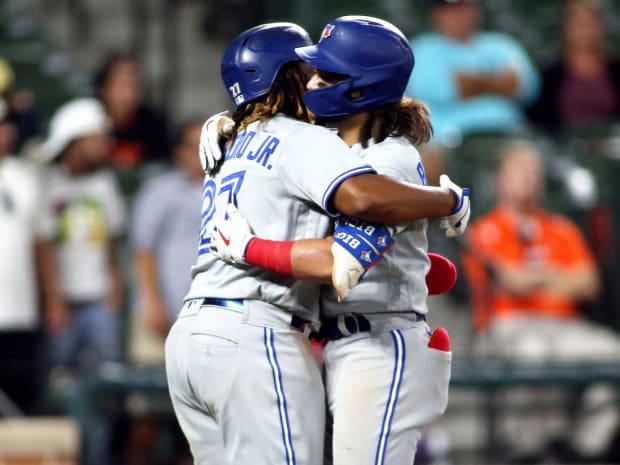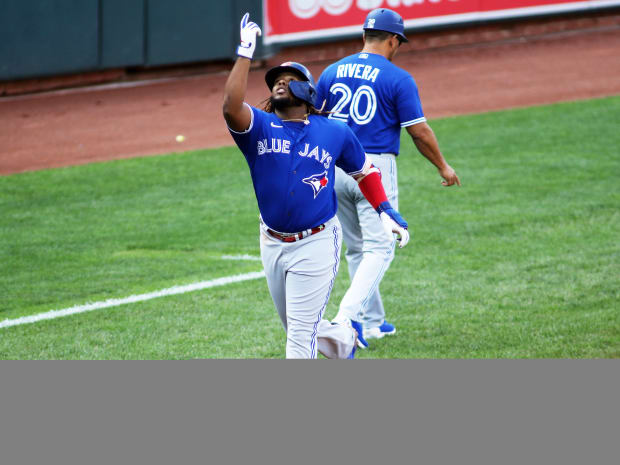They score a ton of runs and their games are the quickest. If this is the future of baseball, we're in luck.
Welcome to The Opener, where every weekday morning you’ll get a fresh, topical column to start your day from one of SI.com’s MLB writers.
What if the Blue Jays are more than just a scorching-hot team? What if scoring 44 runs in their past three games is more than just a mismatch against the woeful Orioles?
Take a wider lens look at the Blue Jays. Then ask yourself this: What if the Blue Jays are the future of baseball?
The answer? We’re all in luck.

Daniel Kucin Jr./USA TODAY Sports
If you’re tired of three-true-outcome baseball, the worship of “driving up the pitch count” of the opposing pitcher, hitters conceding strikes and three-hour-fifteen-minute ball games, Toronto should be your favorite team. The Jays swing early and often. They are the baddest, most hack-tastic, most fastball-chomping, most aggressive-swinging team in baseball.
The Blue Jays have the most first-pitch hits in baseball, highest slugging on first or second pitches and second-lowest strikeout rate. Toronto has broken free from the “take and rake” school of hitting that the Red Sox and Yankees popularized more than a decade ago.
In 2011, the Red Sox and Yankees ranked 1–2 in runs per game and in pitches per plate appearance. Ten years later, none of the four highest-scoring teams even rank in the top 10 in pitches per plate appearance (Rays at 12, Blue Jays at 26, Astros at 14, Red Sox at 16). As velocity has increased and pitch count for starting pitchers keeps lowering because of bullpen depth, “driving up the pitch count” is less meaningful. Toronto has an offense fit for the modern game.
Take a look at what the Jays did Sunday to Baltimore in a 22–7 rout. Here are all of Toronto’s run scoring hits:
Yes, it’s against Baltimore pitching. But among those 10 run-scoring hits, eight of them came off fastballs and six of them on the first or second pitch. The Jays hit .667 against Baltimore fastballs (14-for-21). It’s how they roll.
Toronto has 275 hits on first pitches and slugs .717 on them—a combination of first-pitch bashing never seen before in the 33 years such data has been tracked. No team this year is within 50 hits of Toronto’s first-pitch success.
Watch the Toronto Blue Jays online all season long with fuboTV: Start with a 7-day free trial!
The Jays begin play Monday with one less loss than the Red Sox and the Yankees in the wild-card race. Toronto and New York are playing two different versions of offensive baseball. The Jays play a modern, attacking game. The Yankees play an older, more patient game. Here is how they stack up in some key areas that help define an offensive profile.
How cool is that? The Jays score a ton of runs and their games are the quickest.
Imagine a scale of aggressiveness when it comes to an offensive profile. It can be determined by answering these three key questions about each team.
How often does the team take strikes?
How many hits does the team get on the first or second pitch of an at bat?
How many strikeouts and walks does the team accumulate? (No sense in counting home runs, the third of the three true outcomes; everybody loves homers.)
Here’s what you get:
Each list has a mix of contenders and noncontenders, so be careful about identifying one approach as better. What’s more important is how it fits the personnel, and in many cases key influencers can help dictate what profile a team adopts (e.g., Salvador Perez with the Royals, Bo Bichette with the Jays, Freddie Freeman with the Braves, DJ LeMahieu with the Yankees, Mookie Betts with the Dodgers).
The Jays have the hitters with flatter bat paths who can square up high fastballs to make the aggressive approach work. The MLB average launch angle is 12.5 degrees. Bichette (6.6), Guerrero (8.9), Gurriel (10.7) and Hernández (12.1) all have below-average launch angles.
While pitchers in the Launch Angle era continue to thrive by throwing high fastballs with high velocity (especially with a severe attack angle—throwing high from a low release point), the Jays defeat that strategy. Consider how Toronto fares vs. high fastballs in the strike zone:
Hitting vs. High Fastballs in Zone
The Blue Jays are on a 14–2 run. On Monday they begin a three-game set against Tampa Bay, which has neutralized them while winning eight of 13. But get this: After that the Jays play 10 of their final 16 games against Minnesota and Baltimore, the two worst pitching staffs in the league. Their final three games are against the Orioles. There is a good chance this kind of hitting continues. With a wild-card lead, Toronto controls its playoff destiny.
It was just last week that Ted Simmons spoke eloquently in his Hall of Fame induction speech about the ebb and flow of the game. Simmons is 72 years old. He played 21 years and never struck out more than 57 times in any one of those years. He is from another era. Yet when Simmons called out this plodding three-true-outcome game that we endure today, he did so not with a complaint or snark but with a classy confidence that better days are coming.
“Our game can change back,” Simmons said. “Eventually, another George Brett will surface. He’ll hit .360. He’ll homer 40 times. He’ll drive in 160 runs. He’ll strike out 75 times. He’ll walk a hundred times. His on-base percentage will be .420.
“Our game is fluid. Hitters will begin to beat defensive shifts, and the pendulum will swing back. The game evolves. It’s just a matter of time.”

Daniel Kucin Jr./USA TODAY Sports
He need not wait long, starting with Guerrero, who is on pace to hit .319 with 50 home runs and a .408 on-base percentage—thresholds reached by only seven players in history, none in the past 20 years.
Maybe the Blue Jays are not just a hot-hitting team. Maybe they are the future of hitting—the future that Simmons promised is coming.
More MLB Coverage:
• Vlad Jr.'s Epic Year Shows the Limit of a Triple Crown
• Here Come the Phillies—Can They Rally and Close?
• Marvin Miller: The Late, Reluctant Hall of Fame Inductee
• How MLB Squashed Its Fake-Memorabilia Problem
Sports Illustrated may receive compensation for some links to products and services on this website.